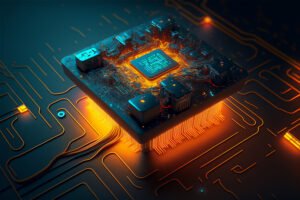FPGAs, or field-programmable gate arrays, have become a ground-breaking technology with broad applications in the aerospace and defense sectors. FPGAs are semiconductor devices that can be customized by engineers to do particular jobs by changing their functionality after they have been manufactured. FPGAs are a highly sought-after solution in dynamic and quickly changing industries like aerospace and defense due to their exceptional versatility.
The main benefits of FPGAs are their capacity for parallel processing, real-time data handling, and customisation, which makes them perfect for addressing the difficult problems encountered in these sectors.
FPGAs are indispensable for high-performance signal processing and data-intensive applications because of their parallel processing characteristics, which enable them to process enormous volumes of data at astonishing speeds. Additionally, FPGAs’ low latency ensures rapid decision-making, which is essential in defense circumstances when millisecond reactions might mean the difference between life and death.
This article will examine the developments of FPGA technology in the aerospace and defense sectors, exploring its many uses and how it is continuing to transform these vital industries.
FPGA Advancements in Aerospace and Defense
The continual advancements in FPGA technology have significantly impacted the aerospace and defense industries, unlocking new possibilities and pushing the boundaries of what is achievable in these critical sectors. These advancements can be attributed to various key areas of improvement that cater to the unique challenges faced in aerospace and defense applications.
A. Radiation Hardening and Reliability
- The effect of radiation on electrical components in aerospace applications is one of the most important factors to take into account, especially for missions in space or high-altitude settings.
- FPGAs are now more resistant to the effects of ionizing radiation thanks to major advancements in radiation-hardening technology. The dependability of FPGAs has been improved, and radiation-induced mistakes have been reduced, by the use of unique design approaches including configuration scrubbing and triple-module redundancy.
- These radiation-resistant FPGAs are now widely utilized in deep space missions, satellite systems, and other radiation-sensitive aerospace applications.
B. High-Speed Signal Processing and Data Handling
- Real-time data processing and handling are in high demand in the aerospace and defense industries. High-speed signal processing jobs benefit greatly from the inherent parallelism of FPGAs and their flexibility to include specialized hardware accelerators.
- FPGAs can effectively manage enormous volumes of data with minimal latency, processing data from radar systems, satellite payloads, or communications systems, allowing for quicker and more precise decision-making in urgent situations.
C. Power and Thermal Efficiency in Extreme Environments
- Systems used in aerospace and military frequently operate in harsh conditions with little power and severe thermal regulations. Compared to conventional processors, FPGAs offer superior performance per watt thanks to considerable advancements in power economy.
- Manufacturers of FPGAs have created energy-efficient products that are ideal for aerospace and defense applications by refining their architecture and implementing cutting-edge fabrication techniques.
- FPGAs are a desirable option for energy-sensitive missions due to their ability to perform specific functions in hardware rather than software, which helps further minimize power usage.
D. Enhanced Security Features
- In the aerospace and defense industries, where sensitive data and communication must be safeguarded against potential dangers, security is of the utmost significance.
- To ensure data integrity and secrecy, encryption and decryption algorithms can be implemented on a reliable hardware platform using FPGAs. To prevent unauthorized access and tampering, FPGAs can also be built with security features like bitstream encryption and tamper detection.
E. Size, Weight, and Power (SWaP) Optimization
- To ensure effective resource use and enable integration into space-constrained platforms like unmanned aerial vehicles (UAVs) and tiny satellites, aerospace and defense systems frequently have strict SWaP requirements.
- The SWaP optimization process benefits from the power efficiency and function consolidation capabilities of FPGAs. Higher levels of integration and shrinking are also made possible by the development of FPGA technology, facilitating the deployment of complex systems in small form factors.
F. Integration with AI/ML for Enhanced Capabilities
- There is a lot of potential for aerospace and defense applications when machine learning (ML) and artificial intelligence (AI) are combined with FPGA technology.
- Accelerating AI/ML algorithms enables improved data analytics, picture recognition, and autonomous decision-making by utilizing the parallel processing capabilities of FPGAs. By combining FPGA with AI/ML technologies, smart, adaptive systems with better situational awareness and performance are being developed.
Applications of FPGA in Aerospace and Defense
Field-Programmable Gate Arrays (FPGAs) have proven to be invaluable tools in addressing the diverse and complex challenges of the aerospace and defense sectors. Their unique combination of parallel processing, real-time capabilities, and customizability has led to their adoption in various critical applications. Let’s explore some of the key applications where FPGAs have made a significant impact:
A. Radar and Signal Processing:
- Real-time Signal Processing for Radar Systems: FPGAs are extensively used in radar signal processing due to their ability to handle large data streams and perform complex algorithms in real time. This ensures precise target detection, tracking, and discrimination capabilities in aerospace surveillance and defense systems.
- Pulse-Doppler Radar Implementation: Pulse-Doppler radar systems, commonly employed in military aircraft and ground-based radar installations, benefit from FPGAs’ ability to process multiple radar pulses simultaneously, enabling enhanced target detection and clutter rejection.
- Synthetic Aperture Radar (SAR) Processing: FPGAs play a crucial role in SAR systems, which generate high-resolution radar images using the relative motion between the radar platform and the target. FPGA-based SAR processing allows for rapid image reconstruction and high-quality results.
B. Communications and Networking:
- Secure Communication Systems: FPGAs are utilized in cryptographic applications, ensuring secure communication channels for sensitive data transmission. Their parallel processing capabilities enable efficient encryption and decryption, vital for safeguarding classified information.
- Software-Defined Radio (SDR) Solutions: SDR leverages FPGA’s flexibility to dynamically adapt to different communication protocols and frequency bands, making it an essential technology in modern communication systems used by military and aerospace agencies.
- High-Speed Data Links: FPGAs are employed in high-speed data link systems to handle the processing and transmission of vast amounts of data, facilitating real-time information exchange in mission-critical scenarios.
C. Image and Video Processing:
- Target Recognition and Tracking: FPGAs enable real-time image processing algorithms for target recognition and tracking, enhancing situational awareness and aiding autonomous guidance systems.
- High-Resolution Image Processing: In satellite imaging and aerial reconnaissance, FPGAs are employed to handle the massive datasets acquired, allowing on-the-fly processing and data compression for efficient storage and transmission.
D. Avionics and Flight Control:
- Flight Control Systems using FPGA: FPGAs have found application in flight control units, enabling precise control and stabilization of aircraft, UAVs, and spacecraft. Their ability to rapidly execute control algorithms enhances flight safety and stability.
- Onboard System Monitoring and Fault Tolerance: FPGAs are used for real-time monitoring of critical onboard systems, ensuring reliable operation and facilitating immediate responses to system failures or anomalies.
E. Cryptography and Information Security:
- Hardware-Based Encryption and Decryption: FPGAs offer hardware-level encryption capabilities that accelerate cryptographic operations, providing robust data protection for aerospace and defense applications.
- FPGA-Based Cryptanalysis Techniques: In certain cases, FPGAs are also utilized to perform cryptanalysis, aiding in assessing the security of cryptographic algorithms and systems.
Conclusion
In the fields of aerospace and defense, FPGAs have emerged as a game-changing technology. Their practical applications have considerably improved communication systems, aviation, radar and signal processing, and image processing. FPGAs’ flexibility, effectiveness, and dependability have sparked innovation in crucial areas. With an emphasis on security and resilience, future developments and integration with AI show enormous promise for ensuring that FPGAs continue to play a crucial role in determining the future of these industries.


![What is FPGA Introduction to FPGA Basics [2023] computer-chip-dark-background-with-word-intel-it](https://fpgainsights.com/wp-content/uploads/2023/06/computer-chip-dark-background-with-word-intel-it-300x171.jpg)









